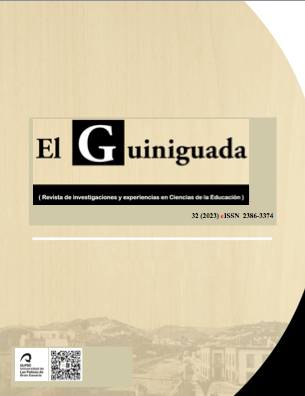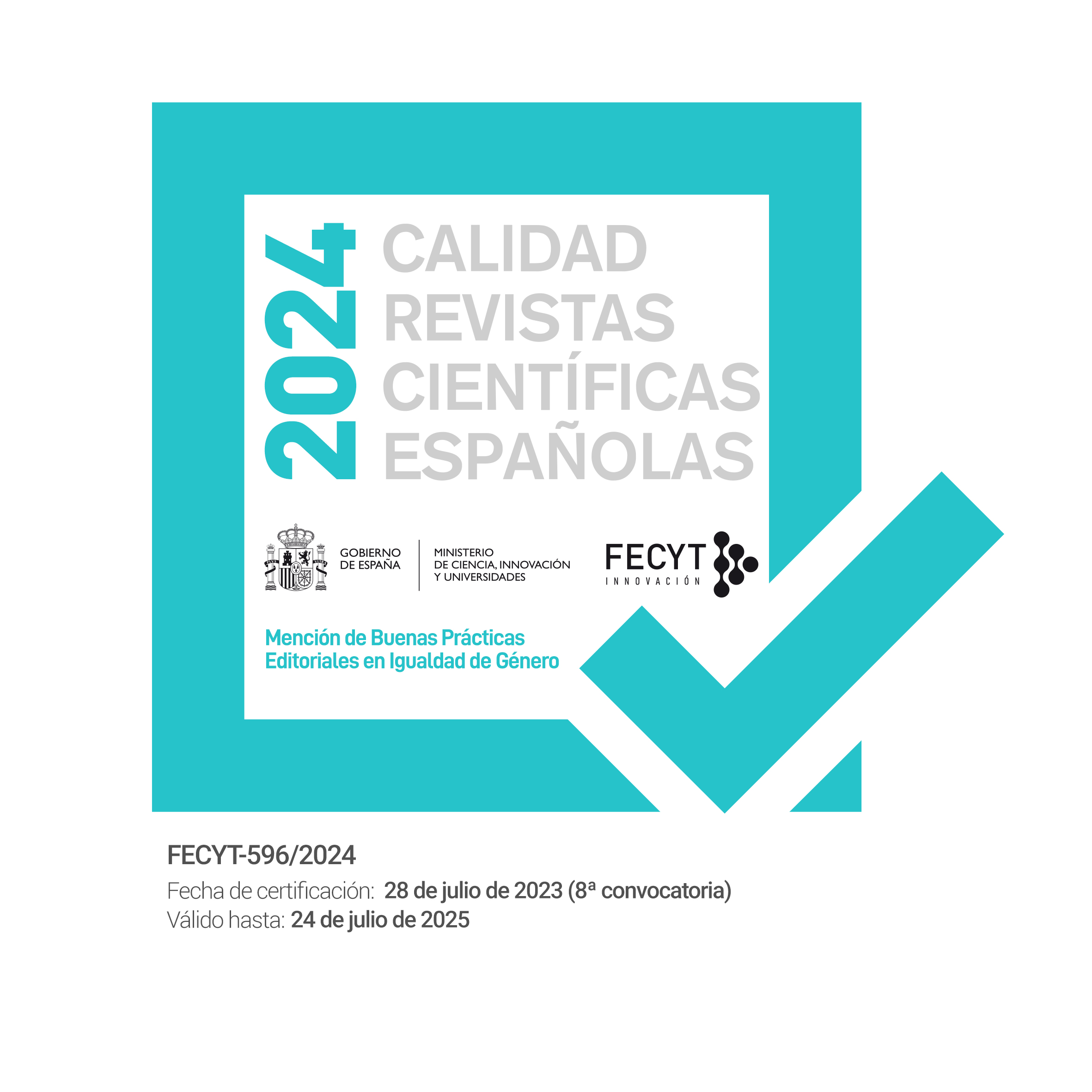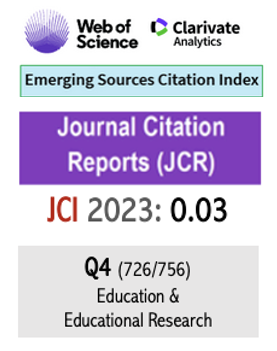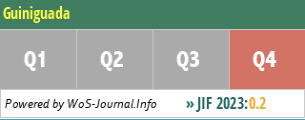The impact of technology-mediated scaffolding on the development of EFL learners’ speaking components. El impacto del andamiaje mediado por tecnología en el desarrollo de los componentes de habla de los estudiantes de inglés como lengua extranjera
doi.org/10.20420/ElGuiniguada.2022.505
Palabras clave:
ANDAMIAJE MEDIADO POR TECNOLOGÍA, DESARROLLO DEL HABLA, ESTUDIANTES DE EFL IRANÍESResumen
The present study attempted to survey the effect of technology-mediated scaffolding on the development of second language speaking components (fluency, coherence, lexical resources, grammatical range, and accuracy, and pronunciation) among Iranian intermediate EFL adult learners. To do so, 60 intermediate level female students with the age range of 18 to 25 in the EFL research center in Tehran were selected from among 90 intermediate students according to their performance in a standard version of the Preliminary English Test (PET). The selected participants were divided into two groups, namely the experimental group (EG) in which the learners received technology-mediated teaching through Telegram application, and the control group (CG), who followed the conventional teaching/learning methods of L2 speaking. The participants went through the process of pre-testing, intervention, and post-testing. Then, the data collected were analyzed, and multivariate ANOVA (MANOVA) was run to probe the null-hypotheses. The outcome of the post-test data analyses clarified that technology-mediated scaffolding had a statistically significant effect on the speaking sub-skills such as fluency, lexical resource, grammatical range and accuracy, and pronunciation of Iranian EFL learners.
Descargas
Citas
Bachman, L. F. (2005). Building and supporting a case for test use. Language Assessment Quarterly, 2(1), 1-34.
Baker, F. S. (2015). Emerging realities of text-to-speech software for nonnative-English-speaking community college students in the freshman year. Community College Journal of Research and Practice, 39(5), 423-441.
Bechhofer, F., & Paterson, L. (2012). Principles of research design in the social sciences. Routledge.
Bruner, J., & Olson, D. (1973). Learning through experience and learning through media. Prospects, 3(1), 20-38.
Burbules, N. C., & Callister Jr., T. A. (2000). Watch IT: The risks and promises of information technologies for education. Westview Press.
Carte, R., & Nunan, D. (2001). The Cambridge guide to teaching English to speakers of other languages. Cambridge University Press.
Celce-Murcia, M. (2001). Language teaching approaches: An overview. Teaching English as a Second or Foreign Language, 2, 3-10.
Chen, C., Toh, S., & Ismail, W. (2005). Are learning styles relevant to virtual reality? Journal of Research on Technology in Education, 38(2), 123-141.
Dehoney, J., & Reeves, T. (1999). Instructional and social dimensions of class web pages. Journal of Computing in Higher Education, 10(2), 19-41.
Ellis, R. (2008). Principles of instructed second language acquisition. Asian EFL Journal. http://asian-efl-journal.com/sept_05_re.pdf
Field, A. (2013). Discovering statistics using IBM SPSS, statistics for statistics (4th ed.). SAGE.
Klopfer, E., Osterweil, S., Groff, J., Haas, J. (2009). Using the technology of today in the classroom today. The Education Arcade. http://education.mit.edu/wp-content/uploads/2018/10/GamesSimsSocNets_EdArcade.pdf
Kim, Y. S. G., Park, C., & Park, Y. (2015). Dimensions of discourse level oral language skills and their relation to reading comprehension and written composition: an exploratory study. Reading and Writing, 28(5), 633-654.
Kozulin, A. (2002). Sociocultural theory and the mediated learning experience. School Psychology International, 23(1), 7-35.
Kumaravadivelu, B. (2003). Beyond methods: Macrostrategies for language teaching. Yale University Press.
Kung, F. W. (2013). Bilingualism and the second generation: Investigating the effects and methods of heritage language maintenance and second language acquisition. English Teaching Journal, 37(3), 107-145.
Larsen, R. E. (1992). Relationship of learning style to the effectiveness and acceptance of interactive video instruction. Journal of Computer-Based Instruction, 19(11), 17-21.
Long, M. H. (1985). Input and second language acquisition theory. In S. M. Gass & C. G. Madden (Eds.), Input in second language acquisition (pp. 377-393). Newbury House Publishers.
Long, M. H., & Porter, P. A. (1985). Group work, interlanguage talk, and second language acquisition. TESOL Quarterly, 19(2), 207-228.
Mackey, A., & Gass, S. M. (2015). Second language research: Methodology and design. Routledge.
Mioduser, D., Nachmias, R., Lahav, O., & Oren, A. (2000). Web-based learning environments: Current pedagogical and technological state. Journal of research on computing in education, 33(1), 55-76.
Mirahmadi, S. H., & Alavi, S. M. (2016). The effect of traditional scaffolding treatments on the Iranian EFL learners’ performance on the speaking sub-skills of pronunciation, fluency, lexicon, and grammar. Modern Journal of Language Teaching Methods, 6(2), 155-168.
Nguyen, M. H. (2013). EFL students’ reflections on peer scaffolding in making a collaborative oral presentation. English Language Teaching, 6(4), 64-73.
Oliver, R. & Herrington, J. (2003). Exploring technology-mediated learning from a pedagogical perspective. Journal of Interactive Learning Environments, 11(2), 111-126.
Pallant, J. (2011). SPSS Survival Manual. A step by step guide to data analysis using SPSS version 18 (4th ed.). Open University Press.
Patel, D. S. (2011). Significance of technology-enhanced language learning (TELL) in language classes. Journal of Technology for ELT, 4(2), 112-121.
Pica, T., & Doughty, C. (1985). Input and interaction in the communicative language classroom: A comparison of teacher-fronted and group activities. In S. Gass & C. G. Madden (Eds.), Input in second language acquisition (pp. 115-132). Newbury House.
Ragan, T., & Smith, P. (1996). Soft technologies: Instructional and informational design research. In D. Jonassen (Ed.), Handbook of research for educational telecommunications and technology (pp. 541-569). MacMillan.
Sadeghi, B., & Maleki, M. (2015). Improving the ability of writing argumentative essays of Iranian EFL learners by raising awareness of rhetoric transfer. Cumhuriyet Science Journal, 36(3), 1541-1559.
Winnips, K., & McLoughlin, C. (2000). Applications and categorization of software-based scaffolding. In J. Bourdeau & R. Heller (Eds.), Proceedings of World Conference on Educational Multimedia, Hypermedia, and Telecommunications 2000 (pp. 1798-1799). AACE.
Yang, Y. T. C., Chuang, Y. C., Li, L. Y., & Tseng, S. S. (2013). A blended learning environment for individualized English listening and speaking integrating critical thinking. Computers & Education, 63, 285-305.
Publicado
Cómo citar
Número
Sección
Licencia
El Guiniguada se distribuye en abierto bajo una licencia Creative Commons Reconocimiento–NoComercial–SinObraDerivada 4.0 Internacional. Permite pues que los autores/as retengan, sin restricciones, los derechos de autoría así como los de publicación y difusión (esta última en una web personal o en un repositorio institucional). Igualmente, los artículos pueden ser descargables y compartirse siempre que se reconozca la autoría, que no se realicen cambios y que no se utilicen comercialmente (CC BY-NC-ND). En los números anteriores a 2020 los derechos de autor/a eran transferidos a la Revista, pero desde el Volumen 29 (2020) se aplica la política de derechos de autoría actual.
La Revista proporciona por tanto un acceso abierto inmediato a su contenido basado en el principio de que ofrecer al público un acceso libre a las investigaciones ayuda a un mayor intercambio global de conocimiento, de acuerdo con la definición BOAI de acceso abierto. Los autores/as no pagan por publicar en El Guiniguada.
El destinatario principal de esta publicación es la comunidad científica en general. No obstante, dado el interés social de los temas vinculados con la educación, El Guiniguada es consciente de la previsible proyección general que sus volúmenes puedan tener. Su acceso abierto permite, igualmente, el conocimiento libre y general de su contenido.
Quienes publiquen en esta revista aceptan pues los términos siguientes:
- Conservarán sus derechos de autoría y garantizarán a la revista el derecho de primera publicación de su obra, el cual estará simultáneamente sujeto a la Licencia de reconocimiento de Creative Commons que permite a terceros compartir la obra siempre que se indique su autoría y su primera publicación en esta revista. Asimismo, se indica que no se puede hacer un uso comercial de la obra; tampoco está permitido su uso derivado.
- Podrán adoptar otros acuerdos de licencia no exclusiva de distribución de la versión de la obra publicada (p. ej.: depositarla en un repositorio institucional o publicarla en un volumen monográfico) siempre que se indique la publicación inicial en esta revista.
- Podrán difundir su obra a través de Internet (p. ej.: en archivos telemáticos institucionales o en los perfiles académicos o profesionales de los autores...) antes y durante el proceso de envío, lo cual puede producir intercambios interesantes y aumentar las citas de la obra publicada. (Véase El efecto del acceso abierto).
Asimismo y de acuerdo con la política de acceso abierto BOAI, todo el contenido está disponible gratuitamente sin cargo para el usuario o su institución. Los usuarios pueden leer, descargar, copiar, distribuir, imprimir, buscar o vincular los textos completos de los artículos, o usarlos para cualquier otro propósito legal, sin solicitar permiso previo del equipo editorial o de la autoría.
















